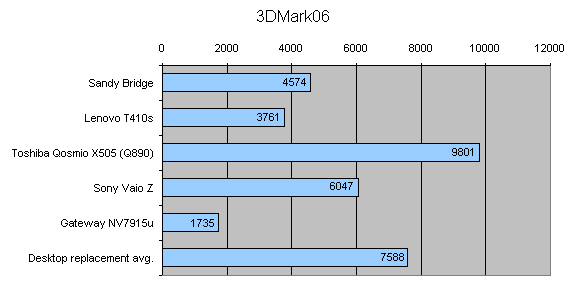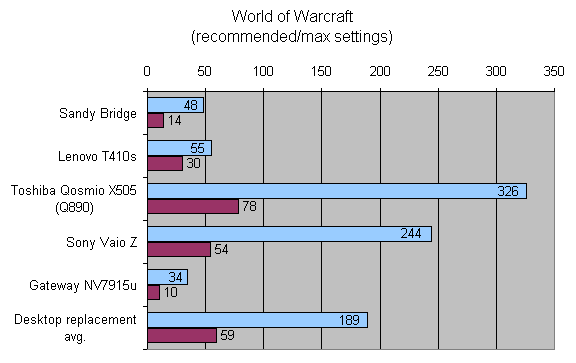Intel 2nd Generation Core Processor Tested: Quantum Leap or More of the Same?
Now that tablets can do a lot of what notebooks can, a lot of people are starting to wonder whether laptops are long for this world. Intel's answer to that question: Sandy Bridge. Officially known as 2nd Generation Intel Core Processors, the brains of next-generation notebooks are all about delivering more content creation muscle and a significant boost in graphics performance. And with a new version of WiDi, you can stream 1080p video from your notebook to your TV--something Apple's AirPlay for the iPad (and even MacBooks) can't handle.
The biggest difference between Sandy Bridge and previous generations is that the GPU is now also manufactured using the 32nm process, and is on the same chip as the CPU. This, according to Intel, not only results in better graphics performance, but will allow for sleeker notebook designs.
Among the new features that Intel is touting are:
Turbo 2.0: While dynamic CPU overclocking was available in the first generation of Intel's new Core Processor family , Sandy Bridge allows the CPU to overclock even higher than before, for a longer period of time.
Quick Sync Video: Enabled by dedicated media processing in hardware, this technology enables faster transcoding of videos using compatible software, such as CyberLink MediaEspresso. As you'll see in our benchmark results, Quick Sync is very appropriately named.
Better Gaming and Video Performance: The new processor graphics inside Sandy Bridge (Intel HD Graphics 2000/3000) is designed to handle mainstream games like World of Warcraft and Need for Speed. If you want DirectX 11 support, go with a discrete GPU. In addition, Intel promises more efficient playback with greater headroom for multitasking, plus the ability to support 3D Blu-ray playback on compatible TVs via HDMI 1.4.
Wi-Di 2.0: This update to Intel’s Wireless Display technology lets users stream 1080p content, and reduces the latency between the transmitter and the receiver. Those who have the first-gen Wi-Di receivers will have to purchase new ones to take advantage of this feature.
Sign up to receive The Snapshot, a free special dispatch from Laptop Mag, in your inbox.
The second-gen Core processors will also have the ability to play HDCP 2 protected content; that means Blu-rays, as well as video streamed from the Internet. However, this added capability will require a driver update, which is expected to hit in April.
How We Tested
Our test system, a Packard-Bell notebook, featured a 2.3-GHz Core i7-2820QM processor, 4GB of DDR3-1600 RAM, a 160GB Intel SSD, and integrated Intel HD Graphics 3000. The 17-inch display has a resolution of 1600 x 900, and the unit also comes with Blu-ray and HDMI 1.4. Intel estimates that the laptop would cost around $2,000 if sold at retail.
We ran a number of our standard benchmark tests on the Sandy Bridge notebook, and compared them to the following systems:
1. Lenovo ThinkPad T410s: 2.66-GHz Intel Core i5-540M, 4GB of RAM, 128GB SSD, Nvidia NVS 3100
2. Toshiba Qosmio X505 (Q890): 1.73-GHz Intel Core i7-740QM, 6GB of RAM, 500GB/7,200 rpm, 64GB SSD, Nvidia GeForce GTS 360M
3. Sony Vaio Z: 2.53-GHz Intel Core i5-460M, 4GB of RAM, dual 64GB SSD, Nvidia GeForce GT 330M
4. Gateway NV7915u: 2.13-GHz Intel Core i3-330M, 4GB of RAM, 500GB/5,400 rpm, Intel HD GPU. This one we used primarily because it also has a 17-inch, 1600 x 900-pixel display and integrated Intel graphics.
General Performance
The power of the Sandy Bridge processor—as well as the Intel SSD—was made obvious when we ran PCMark Vantage, which measures overall system performance. The Sandy Bridge system scored an astronomical 16,283, the highest score we’ve yet seen. By comparison, the Lenovo ThinkPad T410s (2.66-GHz Intel Core i5-560M, 4GB of RAM, and a 128GB SSD) scored 11,264.
We also ran a script in Microsoft Excel that uses the BLookup function to match 65,000 names in one sheet with address in another sheet. The Sandy bridge system finished the task in 17 seconds; it took the Vaio Z 44 seconds, and the X505 took 1:19. Again, very impressive.
Quick Sync (Video Encoding)
The real-world power of Sandy Bridge became apparent when used CyberLink MediaShow Espresso for video transcoding. This program was optimized for Intel's new Quick Sync video technology. We took a 5-minute 1080p video and converted it to an iPod touch format; the Sandy Bridge system took just 24 seconds, more than a minute faster than the T410s (1:35) and X505 (1:36). For those scoring at home, that's crazy fast.
The Sandy Bridge system also used its processor more efficiently; on the T410s and the X505, all cores were going full blast; on the Sandy Bridge system, only 4 of the cores were used, and even then, they were only modestly taxed. We also ran the test with hardware encoding turned off; it took a full minute longer, even with all 8 cores being used.
Using Oxelon Media Encoder, we converted a 114MB MPEG4 to AVI. We then used Cyberlink Mediashow Espresso to convert a 5-minute 1080p clip to an iPod touch format. In both instances, we saw a general improvement, as the Sandy Bridge system was able to convert the files faster than anything before. It took just 35 seconds for the Oxelon test, about twice as fast as the desktop replacement average, and 11 seconds faster than the Lenovo T410s.
Graphics Performance
As a result of the GPU being on the same die as the CPU, Intel says that its Processor Graphics delivers up to double the performance versus the previous generation. While it’s not often you have a quad core CPU paired with only integrated graphics—we did notice an improvement.
In 3DMark06, which measures graphics performance, the Sandy Bridge system scored 4,574; while that showing is below the desktop replacement average (7,588), we have to keep in mind that the latter score includes a number of notebooks with discrete graphics. Even so, it bested the Lenovo T410s, whose Nvidia NVS 3100 GPU only scored 3,761. Our test Sandy Bridge notebook also beat the Samsung R540 with ATI Mobility Radeon HD545v graphics (4,383). Then again, this is a quad-core system, which helps speed up gaming. We'd be interested to see how dual-core Sandy Bridge notebooks perform with Intel's new Processor Graphics.
Gaming Performance
Intel says that Sandy Bridge will let users play mainstream games with just its new Intel HD Graphics. In World of Warcraft, we set the screen resolution to native (1600 x 900), and selected the graphics settings to recommended. Our test laptop notched 48 frames per second, which is more than playable. The Lenovo T410s with discrete Nvidia graphics saw 55 fps at these settings. When we cranked up the graphics to max, the Sandy Bridge notebook dropped to 14 fps, half that of the T410s (30 fps), and about a fifth of the desktop replacement average (12 fps).
These W.O.W. results are better than what the Gateway NV7915u turned in last year, which had integrated graphics and a 17-inch, 1600 x 900-pixel display. It notched 34 and 10 fps, respectively, on the same tests.
When we fired up Far Cry 2, the Sandy Bridge notebook saw 20 fps at autodetect and a screen resolution of 1024 x 768; at native resolution and graphics set to Very High, that number dipped to 9 fps. Both figures are roughly double that of the Gateway NV (11/4 fps, respectively), but you still wouldn’t want to game on it. Serious gamers will step up to ATI or Nvidia GPUs.
WiDi 2.0
Intel’s Wireless Display technology has been upgraded so that it can now stream 1080p content, up from just 720p in the first generation. Latency has also been reduced greatly. When we mirrored our test notebook’s display with a 32-inch Samsung 1080p TV, videos stored on the notebook--such as the Iron Man 2 trailer--were just a hair behind on the larger screen.
Connecting the notebook wirelessly is just as simple as before. Simply plug the receiver into your HDTV using HDMI or component cables. Then, using the software on the notebook, search for and link to the receiver. After entering a security code, it took just 12 seconds for the WiDi connection to start working.
Using just the Samsung TV, we were able to output 1080p videos, such as a Quicktime Iron Man 2 trailer and The Magic of Flight WMV, in their full glory. We noticed just a little hitching, but audio and video were fully synced, even when we moved the notebook a good 15 feet away from the receiver.
When moving the cursor around, we barely noticed any latency; while it’s not as seamless as, say, Asus’ or HP’s WHDI solutions, WiDi is pretty darn good for a technology that’s built into a laptop.
Unfortunately, you can’t use WiDi 2.0 to play protected content, such as DVDs or Blu-rays; that feature will become available later this year. When we tried playing World of Warcraft, the notebook turned off WiDi. Still, we were able to stream videos from Hulu and YouTube (such as DJ Earworm's United States of Pop 2010) without any problem.
Battery Life
Aside from size, the other advantage of putting both the GPU and the CPU on the same die is improved power consumption. While not a highly touted feature of Sandy Bridge, we did notice better endurance when running the LAPTOP Battery Test.
Our Sandy Bridge notebook outlasted all the others we compared it to; the most significant comparison of the group would be the Gateway NV7915u, which has the same size screen and integrated graphics. The Sandy Bridge notebook lasted 2 hours and 19 minutes longer; while endurance isn't the first thing we look for in a desktop replacement notebook, it is nice to know that you can compute for longer unplugged. This increased efficiency also bodes well for lighter dual-core Sandy Bridge laptops expected to hit the market soon.
Verdict
So there you have it; Intel’s new Sandy Bridge processor family provides significantly better performance, especially when using software that can take advantage of its Quick Sync technology and hardware acceleration. Content creators will love what this new platform has to offer. While the new combo CPU/GPU won't take the place of discrete graphics for those who play the most demanding titles, Intel's new Processor Graphics do perform better than previous generations. And although we tested a 17-inch notebook, we were pleasantly surprised that our Sandy Bridge laptop lasted much longer on a charge than other systems in its class.
It should be remembered, though, that our test system was equipped with not only a quad-core processor but an Intel SSD, so the performance deltas we saw will likely diminish when consumers get dual-core Sandy Bridge systems with traditional hard drives in their hands. Nevertheless, Sandy Bridge represents a significant milestone for Intel and will wow power users who want to own the fastest notebooks money can buy.
Michael was the Reviews Editor at Laptop Mag. During his tenure at Laptop Mag, Michael reviewed some of the best laptops at the time, including notebooks from brands like Acer, Apple, Dell, Lenovo, and Asus. He wrote in-depth, hands-on guides about laptops that defined the world of tech, but he also stepped outside of the laptop world to talk about phones and wearables. He is now the U.S. Editor-in-Chief at our sister site Tom's Guide, where he oversees all evergreen content and the Homes, Smart Home, and Fitness/Wearables categories for the site..












